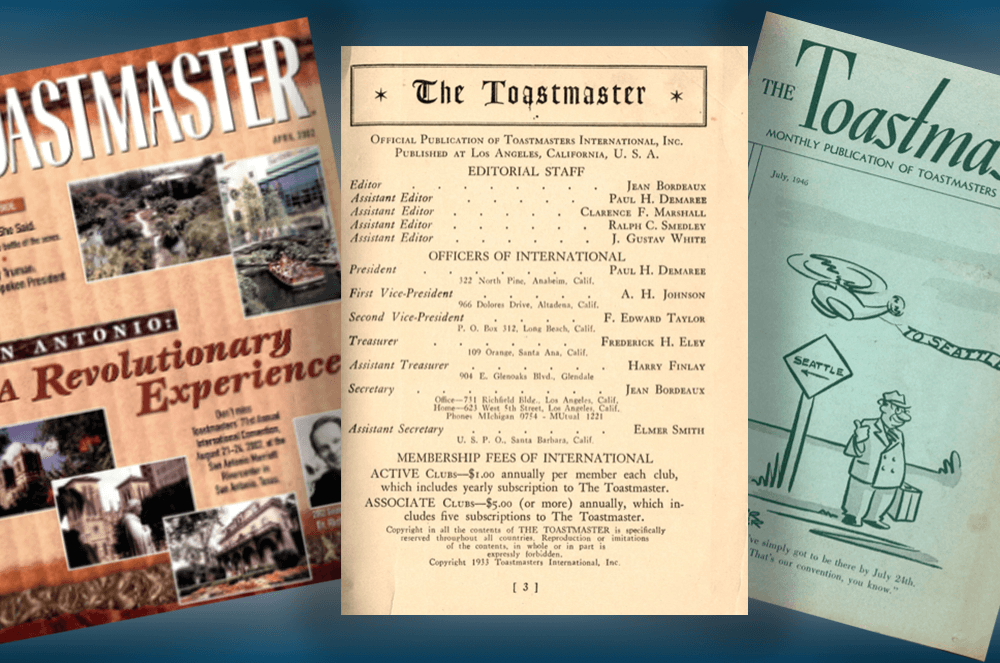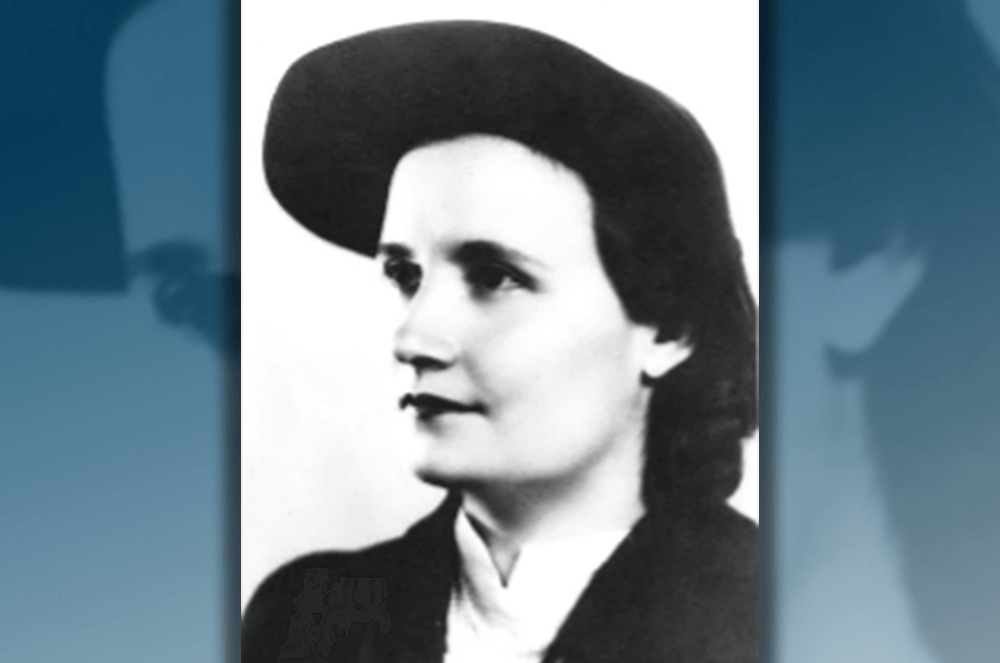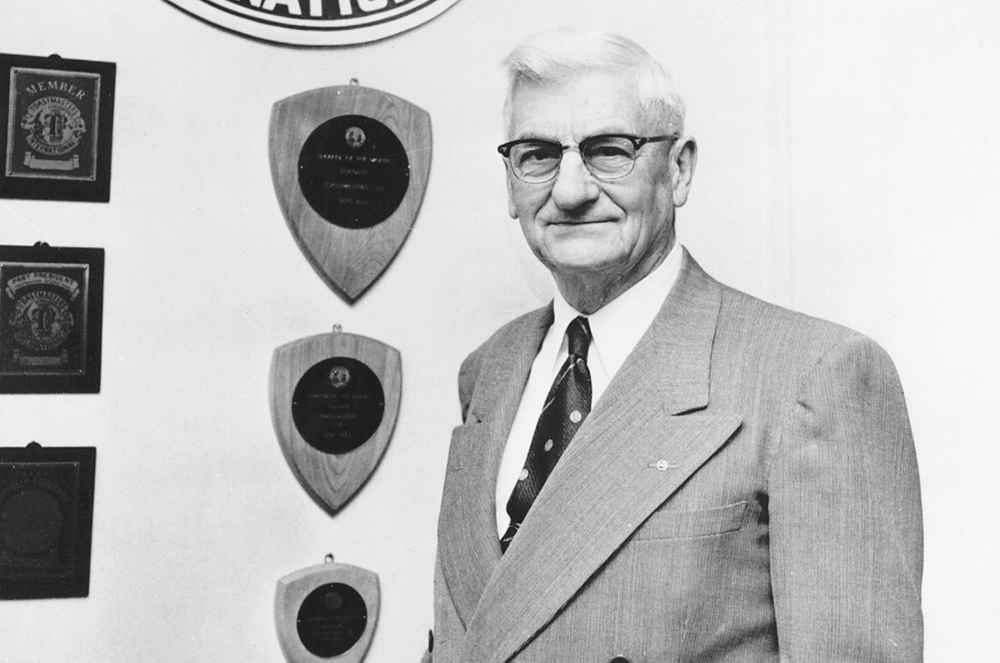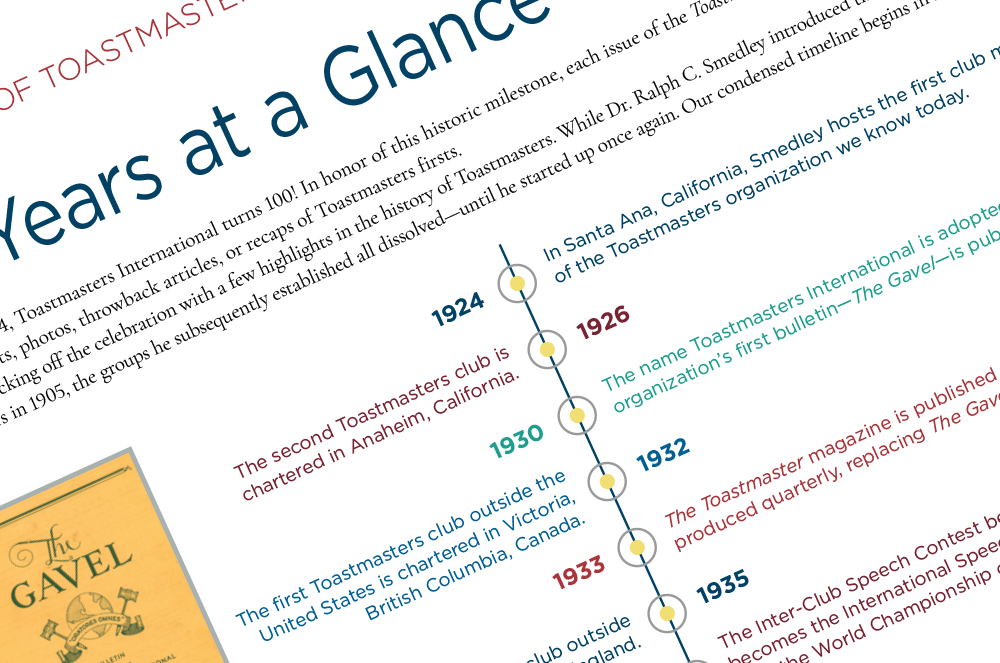
When the Toastmaster magazine debuted in April 1933—nine years after the Toastmasters organization began—it was a very modest package: less than 20 pages long, measuring only 6 inches by 3 inches, with news items about the mere 12 clubs that existed then.

But it was the start of something big. Since that time, the magazine has chronicled the ever-evolving world of Toastmasters, and now reaches more than 270,000 members in 148 countries. Over the years, the publication has spotlighted countless members around the globe; provided insight on wide-ranging, relevant communication and leadership topics; featured a creative expanse of photographs, graphics, and illustrations; and produced digital content that continues to expand in exciting ways.
Read on for highlights in the Toastmaster’s history.
The precursor to the magazine was The Gavel, a newsletter the organization started in 1930. It was a small, six-page mimeographed bulletin with a few pages of notices and a letter from Toastmasters founder Dr. Ralph C. Smedley.
A few years later, The Gavel graduated to a magazine: The Toastmaster. For the first 70 years of its existence, the publication was called The Toastmaster. In 2004, The was removed and it’s since been Toastmaster magazine. At the start, the magazine came out four times a year; in 1942 it became a bimonthly magazine, and has now been monthly since 1946.
What was in that debut issue of The Toastmaster? Mostly items about the existing clubs, a few short editorial pieces, a Critique Sheet (an early version of a speech evaluation form), and a column dubbed “Gavel Splinters,” described as exploring “the good and bad points of International, with some occasional ‘backdoor’ philosophy.” There was also a baby announcement of sorts, under this headline: “Seattle Club: Mr. and Mrs. Seattle are Proud To Announce the Birth of Their First Toastmaster’s Club.”

In its initial years, the magazine included a complete roster of clubs, a smattering of jokes and humorous anecdotes, quizzes, and articles. A column by Ralph C. Smedley was also a mainstay. What’s interesting is how similar the topics of that time are to what Toastmasters still talk about today. Early articles looked at taming nerves, how to treat guests, choosing effective speech topics, how to add variety to Table Topics®, and highlights of the year’s International Convention. One story was on the timeless question of how to properly end your speech: “To Thank or Not to Thank.”
All clubs were asked to send in news items about their groups—and apparently risked a public shaming if they failed to do so. From the March 1935 magazine: “We regret the lack of news from Indianapolis and Tucson. These are the only clubs in International which failed to get their reports in for this issue.”
Advertisements had a breathless quality, like a 1937 Toastmaster ad promoting the upcoming convention in Hollywood, California— “GLAMOROUS ALLURING EXOTIC HOLLYWOOD … the Home of the Stars, the Goal of the Aspiring, the Focus of the Spotlight.”
Anniversary issues were always packed with gems about Toastmasters history. The 40-year anniversary issue of October 1964 included a letter signed by then-U.S. President Lyndon B. Johnson (“Toastmasters International is developing thinking citizens who participate in community affairs and whose articulate leadership contributes much to making democracy work.”)
Some content reflected the times. That same 1964 issue included a short item about a District officer touting the value of clubs holding regular “Ladies’ Nights”—because, after all, as the piece explained, “If a wife knows and understands Toastmasters, she will lend her mate more support in his Toastmastering efforts.”
Editorial Leadership
The magazine’s editorial direction has been charted by a long list of talented editors, including Smedley, who guided it for more than 20 years. Among the many who followed him was Suzanne Frey, who took over in 1986 and edited the Toastmaster for nearly 35 years. She gave it a more contemporary feel, and as a native of Sweden, brought an important international perspective to the publication, making it a mission to feature more stories on members outside North America.
The magazine published stories about the late Filipino leader Cory Aquino, the dramatic growth of Toastmasters in Europe, Asia, India, and Sri Lanka; and the intricacies and importance of cross-cultural communication.
Artwork in the magazine also evolved through the years. In the early decades, most visual imagery came in the form of illustrations, including magazine covers. Burr Shafer, a nationally prominent cartoonist (and a Toastmaster), provided a number of cartoons used for Toastmaster magazine covers in the 1940s.

By the late 1980s, color print and photographs were used on two or three of the main articles in each issue. Then in 2002, the magazine began using color throughout the entire issue, sparking even more visual creativity in subsequent years. With her innovative layout designs, longtime graphic designer Sue Campbell has left her visual imprint on the magazine.
With the rapid rise of online publications, the magazine adapted as well, and by 2011, members could enjoy a PDF flipbook online, followed two years later by a tablet app. In October 2016, the magazine launched its first web-based edition, and has continued to evolve the last eight years.
In 2020, COVID posed unanticipated challenges for Toastmasters. The magazine quickly began publishing scores of articles related to online communication, such as tips about virtual club meetings and how to present on Zoom. In addition, the print edition was suspended—the first time in the organization’s history—for financial and logistical reasons, and the focus turned to the digital edition. The magazine now is published online every month, along with a PDF version that is laid out like a magazine.
After more than 90 years of publication, and tens of thousands of articles, the Toastmaster magazine still aptly reflects the core principles that Smedley laid out for the magazine years ago, including this goal:
“To produce a magazine which would be of maximum help to the clubs and to their individual members.”
To browse the archives of the Toastmaster magazine, go to the Explore page and filter by year.
In honor of Toastmasters International’s 100th anniversary, this is the fourth in a year-long series of articles commemorating historic milestones.
The Toastmaster magazine staff is composed of four editorial team members. Learn more about them on the Staff page.
Related Articles

Toastmasters History
International Toastmistress Clubs

Toastmasters History
Remembering Dr. Ralph C. Smedley

Toastmasters History



 Previous
Previous

 Magazine History Quiz
Magazine History Quiz
 Previous Article
Previous Article